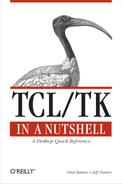What Is Tcl?
In the early 1980s John Ousterhout, then at the University of California at Berkeley, was working with a group that developed hardware design tools. They found that they kept inventing a new scripting language with each new tool they developed. It was always added as an afterthought and poorly implemented. John decided to create a general-purpose scripting language that could be reused when developing new tools. He called the language Tcl, for tool command language, made it freely available for download, and presented it at the Winter 1990 USENIX conference. It soon became popular, with an estimated 50 Tcl applications written or in development one year later.
One of the attendees at Ousterhout’s presentation, Don Libes, saw the applicability of Tcl to a problem he was working on. Within a few weeks he developed the first version of Expect, which became the first killer application for Tcl, driving many people to install Tcl who might have otherwise ignored it.
Ousterhout’s philosophy is to embed a scripting language inside applications. Combining the advantages of a compiled language like C (portability, speed, access to operating system functions) with those of a scripting language (ease of learning, runtime evaluation, no compilation) gives an overall reduction in development time and opportunities for creating small, reliable, and reusable software components. An application with an embedded Tcl interpreter can be extended and customized by the end user in countless ways.
The Tcl interpreter has a well-defined interface and is typically built as an object library, making it easy to extend the basic language with new commands. Tcl can also be used as a prototyping language. An application can be written entirely in Tcl, and once the design is proven, critical portions can be rewritten in C for performance reasons.
A year later, at the Winter USENIX conference, Ousterhout presented Tk, a graphical toolkit for Tcl that made it easy to write applications for the X11 windowing system. It also supported the send command, a simple yet powerful way to allow Tk applications to communicate with each other.
Since then, with dozens of Tcl extensions, many of them designed to solve problems related to specific domains such as graphics and relational databases, the Tcl programming environment has become even more powerful. Today, Tcl runs on Unix, Macintosh, and Windows platforms, and even inside a web browser. It has a huge installed base of users and applications, both free and commercial. As Tcl approaches its tenth anniversary, it is poised to continue its growth in popularity.
